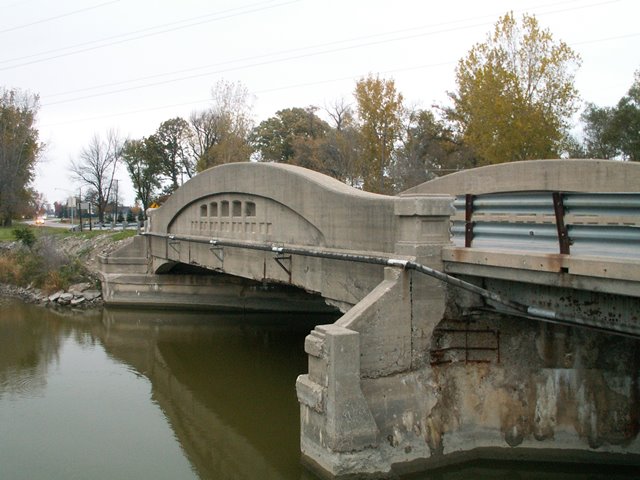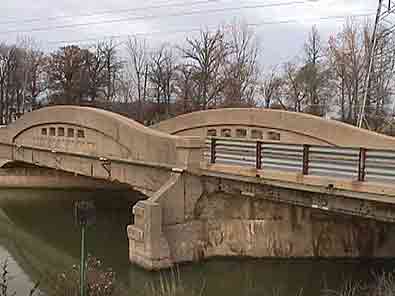We Recommend:
Bach Steel - Experts at historic truss bridge restoration.
BridgeHunter.com Phase 1 is released to the public! - Visit Now
Portsmouth Road Bridge
Indiantown Bridge

Primary Photographer(s): Nathan Holth
Bridge Documented: April 11, 2006
Indiantown: Saginaw County, Michigan: United States
1921 By Builder/Contractor: L. A. Davidson of Saginaw, Michigan and Engineer/Design: Michigan State Highway Department
1930
70.0 Feet (21.3 Meters)
125.0 Feet (38.1 Meters)
24 Feet (7.32 Meters)
1 Main Span(s) and 1 Approach Span(s)
73200140000B010

View Information About HSR Ratings
Bridge Documentation
This bridge no longer exists!
View Archived National Bridge Inventory Report - Has Additional Details and Evaluation
Learn about Michigan's Unique Concrete Camelback Bridges

This bridge was an excellent example of a medium sized concrete camelback bridge. Cheboyganing Drain must have been dredged and widened after this bridge was built, most likely in 1930, a date referenced in the National Bridge Inventory. If you look at the above photo you can see that the southern abutment of this slightly skewed bridge now acts as a pier. A steel stringer span was added to the bridge, to give the bridge an approach. The northern end remained unchanged. The condition of the concrete appears to be decent, with some minor spalling. Oddly, a three ton weight limit was posted. Three tons was very light for this sort of a bridge. Three tons is the lowest weight limit that a bridge open to traffic is allowed to have in Michigan. It should be noted that the girders themselves could likely have supported a maximum legal load, if there was any structural issues it would have been with the deck or abutments.
Saginaw County Road Commission made a terrible decision by choosing to demolish this beautiful structure, rather than preserve it for future generations to enjoy. Regardless of money, rules, policy, current public interest, or any other factor, there is no acceptable excuse for the demolition of a bridge such as this one, despite the fact that this event is being repeated across the state at an alarming rate. The demolition of this bridge suggests a need for vast changes to transportation and historic bridge preservation policy. Clearly, the limited policies in place to protect historic bridges are not working.
The 1995 historic bridge inventory of Michigan suggested perhaps less than 50 remained in the state. Currently, there are far less than that. As countless counties and DOTs around our nation go about preserving wooden covered bridges, these bridges are being demolished, despite their greater historic significance. Indeed, these 1920s bridge are more significant than most 1860s covered bridges because this bridge type, the concrete curved chord through girder, was only built with frequency in Michigan. As a result, they are extremely rare on a national scale, and each one of these bridges is nationally significant. Covered bridges were built all over the country, and a greater number of them remain across this country.
Information and Findings From Michigan Historic Bridge InventoryNarrative Description This is the oldest known surviving example of a standard Michigan State Highway Department concrete camelback bridge of 70 feet. Michigan's Highway Department developed standard designs in the late 1910s as a way of producing inexpensive bridges for the State Trunkline System, and was a national leader in doing so. L.A. Davison & Company was the contractor for this bridge.
|
![]()
Photo Galleries and Videos: Portsmouth Road Bridge
Bridge Photo-Documentation
Original / Full Size PhotosA collection of overview and detail photos. This gallery offers photos in the highest available resolution and file size in a touch-friendly popup viewer.
Alternatively, Browse Without Using Viewer
![]()
Bridge Photo-Documentation
Mobile Optimized PhotosA collection of overview and detail photos. This gallery features data-friendly, fast-loading photos in a touch-friendly popup viewer.
Alternatively, Browse Without Using Viewer
![]()
Maps and Links: Portsmouth Road Bridge
This historic bridge has been demolished. This map is shown for reference purposes only.
Coordinates (Latitude, Longitude):
Search For Additional Bridge Listings:
Bridgehunter.com: View listed bridges within 0.5 miles (0.8 kilometers) of this bridge.
Bridgehunter.com: View listed bridges within 10 miles (16 kilometers) of this bridge.
Additional Maps:
Google Streetview (If Available)
GeoHack (Additional Links and Coordinates)
Apple Maps (Via DuckDuckGo Search)
Apple Maps (Apple devices only)
Android: Open Location In Your Map or GPS App
Flickr Gallery (Find Nearby Photos)
Wikimedia Commons (Find Nearby Photos)
Directions Via Sygic For Android
Directions Via Sygic For iOS and Android Dolphin Browser
USGS National Map (United States Only)
Historical USGS Topo Maps (United States Only)
Historic Aerials (United States Only)
CalTopo Maps (United States Only)


